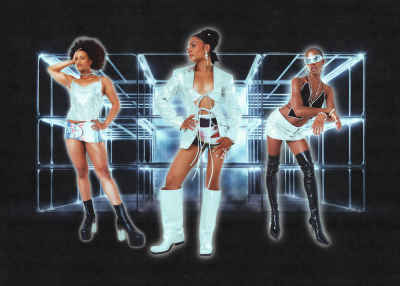
What to wear to Beyoncé’s Renaissance World Tour, her first solo tour in seven years and first public performance since releasing an album last July? Silver, basically. Platinum. Iridescence. Chrome. Diamonds. Foil, if you must. You can’t go wrong with the now-famous disco cowboy hat Beyoncé pairs with a Nusi Quero bodysuit and silver-fringed chaps in the image that would become the tour’s sole promotion until opening night. All signs pointed to silver: She donned a silver Gucci dress at the 2023 Grammys; silver-paneled Gareth Pugh and silver Amina Muaddi heels for the Roc Nation Brunch. At her own gold-themed Oscars after-party, the host wore gold then changed into silver. Onstage, even the wind machines wear it.
Silver, unlike gold, feels like the future. Designer and Studio 54 darling Elsa Peretti reintroduced the material through her highly successful contract with Tiffany & Co. in 1974. Her silver jewelry was sold to a growing population of independent women who, resolving to buy their own diamonds and their own rings, chose the more affordable precious metal. Peretti’s silver renaissance marked the first time the company sold silver in 25 years. In Beyoncé terms, it is the span from Destiny’s Child’s debut album in 1998 to the announcement of 2023’s Renaissance World Tour for which Tiffany & Co. serves as official jeweler, crafting a collection of custom silver items worthy of theming a Met Gala.
On July 8, 2023, Beyoncé entered Toronto’s Rogers Centre wearing a Peretti-inspired, custom-made Tiffany nude-illusion minidress draped in Peretti’s iconic “Diamonds by the Yard” design, circular Tiffany earrings, a Tiffany ring, a Tiffany anklet, and transparent heels by Malone Souliers. Her toes were painted red. Like Beyoncé, I glittered (just so) in a custom “ALIEN SUPERSTAR”-inspired bedazzled tank top created in collaboration with my mother, a pair of gray (humble silver) Y-3 shorts, and Rick Owens boots, under which no toes were painted.
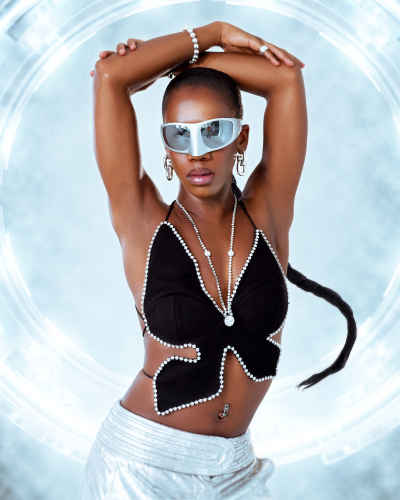
Miss Chris wears AREA camisole, Simon Miller skirt, Linda Farrow sunglasses, Paco Rabanne earrings, Jil Sander ring and Jil Sander bracelet. Top Image: Kuntiana (left) wears Paco Rabanne blouse, Diesel skirt, Rick Owens boots, Mugler necklace, Jil Sander ring and Jil Sander bracelet. Syana (middle) wears Lado Bokuchava blazer, 1XBLUE skirt, FIDAN NOVRUZOVA boots, Magda Butrym earrings, HUGO KREIT ring and Jil Sander bracelet. Miss Chris (right) wears AREA camisole, Simon Miller skirt, Diesel boots, Linda Farrow sunglasses, Paco Rabanne earrings, Jil Sander ring and Jil Sander bracelet.
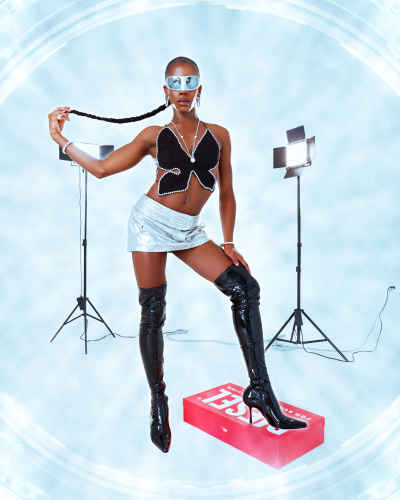
Miss Chris wears AREA camisole, Simon Miller skirt, Diesel boots, Linda Farrow sunglasses, Paco Rabanne earrings, Jil Sander ring and Jil Sander bracelet.
“I love you,” she said, ascending onstage veiled in spherical fog as if on a cloud. As she said this, the wind machine—on beat—blew it all away to synchronous, wild uproar. Beyoncé was fully present, her dimpled smile more dazzling than her slinky diamond outfit. A rosy dawn backdrop illuminated the audience. “I love you too!” I shrieked. She was so close I presumed she could hear me.
Always favoring a surprise, Beyoncé’s opening was a bait and switch. The sun set on a segment of ballads as we gained entry to the night world of RENAISSANCE, an album as sonically serious and sometimes menacing as it is silly, joyous, and proud. It seeks to recognize a Black LGBTQ+ history through the tradition of club and ballroom culture and offers escapism as a mechanism to achieve your future self. In a video introduction, Beyoncé transforms into a Hajime Sorayama-esque robot. “Motherboard” is emblazoned on the screen. Beyoncé reemerges onstage as that robot, Metropolis-style: inanimate, majestic, silver. The ecoskeletal panels are released to reveal Balmain-Beyoncé. Geometric appliqués gave the long-sleeved bodysuit an appearance of corseted silver armor. She is not weighed down—she glides, hitting robo-choreography with abundant and playful pride.
In other cities, this entrance unveils an asymmetric silver leotard with holographic gray thigh high boots. In classic Courrèges-futuristic approach, the waist features a circular cutout into which is set a round piece of metal. The detail feels similar to the 1969 stainless-steel belt Mary Ann Scherr designed for Miss Ohio with its centered, large circle at about the same spot. The belt was inspired by Neil Armstrong’s moon landing but its space concept wasn’t just aesthetic; it also measured the wearer’s heart rate, combining notions of beauty with human-machine hybridity.

Kuntiana wears Simon Miller dress, Bottega Veneta sandals, Versace sunglasses, Paco Rabanne earrings and Jil Sander ring.
I checked my pulse several times throughout the show. Up close Beyoncé is a lot to take in. Ferociousness becomes exuberance; profundity becomes a bubbly laugh; a single lyric produces coquettish sex appeal, queenly confidence, contorted wackiness, and back again to the fun she’s having. In contrast to 2016’s The Formation World Tour, which inherited Lemonade’s statements on personal strife and sociopolitical commentary, this Beyoncé feels looser and unhurried, breaking character to giggle as if showing friends her big show. Renaissance’s meditations have gravity, but are soft and libidinous, careening between audacious self-aggrandizement, romantic fulfillment, and joy. On tour, the audience encourages her: “YES!” “WORK!” An audience member near me opened and closed his fan to the rhythm of her music, the percussive clacks placing ballroom front and center. I saw how she received our elation and mirrored it back. It is a circle of reciprocal bliss. She does this in silver, but also in as vibrant a color as Barbie-pink, alien-eye sunglasses styled with an IVY PARK dress with a cut that situates the past (Tina Turner, Bob Mackie, Studio 54), with a make that represents the present (IVY PARK is her own brand) and with a result that’s something we’ve never seen before: impossibly glamorous athleisurewear.
An on-screen Einstein quote—“IMAGINATION IS MORE IMPORTANT THAN KNOWLEDGE”—situates futurism as Beyoncé’s mode du jour: You cannot achieve that which you cannot imagine. In the tradition of 1970s Afrofuturism she envisions an alternative tomorrow, expanding the concept by unpacking the past, blasting us into a celebration of culture. “Black lights / spaceships fly,” Beyoncé sings on “CUFF IT.” Her dancers’ explosive energy, ballroom legend Kevin Jz Prodigy’s instantly classic tour narration, and the name “Grace Jones” invoked at least four times over the course of the concert act as fuel for our liftoff.

Kuntiana wears Paco Rabanne blouse, Diesel skirt, Mugler necklace, Jil Sander ring and Jil Sander bracelet.
On October 6, 1974, futuristic trio Labelle (of “Lady Marmalade” fame) played the Metropolitan Opera House in New York. Designer Larry LeGaspi (who often dressed Grace Jones) costumed singers Patti LaBelle, Sarah Dash, and Nona Hendryx to reflect their forward-looking sound: silver shoulder pads edged with black feathers, sexy silver breastplates and a circular silver necklace, a rhinestoned white catsuit topped with a massive plumed hat. When Labelle descended onto the stage, they did so as the first Black pop group to ever play the venue, as significant for them as for who sat in the theater: a racially diverse crowd of drag queens, straight folk, and queers alike, all of whom must have found a slice of home in the expressive music and style of Labelle. The New York Times reported, “Met’s opera audience [came] out of the closet: there can rarely have been so many bearded gentlemen in dresses, razzledazzle sequins and arched eyebrows at a Met performance.” The previous evening was a performance of Mozart’s “Don Giovanni.” The Labelle event advertised: “WEAR SOMETHING SILVER.”
Not everyone wears silver to the Renaissance World Tour. Other colorful metallics are chosen. I saw a pink lamé “Freakum Dress” and Beyoncé T-shirts tied to create a better fit. Fringe dangled wherever fringe might desire to dangle. There were re-creations of popular current tour looks: the rigid chrome-painted Mugler bee outfit worn with helmeted antennae, its impressive presentation as much a topic of conversation as Beyoncé’s near-struggle to move in it; the beloved Loewe FW23 trompe l’œil Birth of Venus dress, Beyoncé-coded in sparkly catsuit format plus duplicated gloves. Those not in silver added the contrast so silver fans appeared like drops of mercury trickling into their seats. For those in casualwear, the event was less Studio 54 and more Paradise Garage, where DJ Larry Levan’s nonstop grooves and a no-camera rule produced patrons more likely to wear sweatpants than Halston. For Beyoncé, rehearsals are the closest she’ll get to performing in sweats. As she states in “ENERGY”: “I’m gon’ be extra when that camera go pop, pop, pop, pop, pop, pop.”
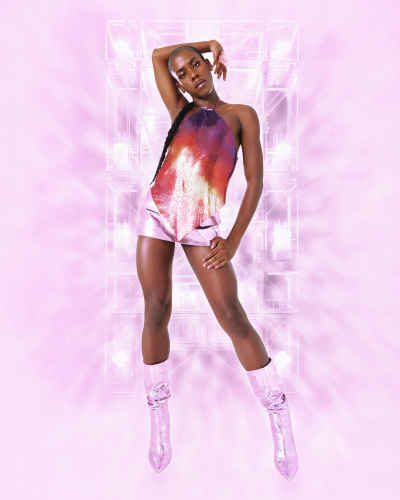
Miss Chris wears Paco Rabanne top, Lado Bokuchava skirt, Paris Texas boots and La Manso ring.
So far on tour, Beyoncé has worn many of fashion’s most exciting names, new and old: Iris van Herpen, David Koma, LaQuan Smith, Jaquemus, Ibrahim Kamara for Off-White, Maximilian Davis for Ferragamo, Alberta Ferretti, Carolina Herrera by Wes Gordon, Schiaparelli, Feben, Diesel, Stella McCartney, Richard Quinn, Georges Hobeika, Valentino, Roksanda, Alexander McQueen, Acne Studios, Mary Katrantzou, Andreas Kronthaler for Vivienne Westwood, ROBERT WUN, Marine Serre, Givenchy, Fendi, Paco Rabanne. The list continues. Each night of the Renaissance World Tour promises one, if not several, custom costume debuts, many of which come with publicity from the brand detailing just how special the garments are, making the tour a sartorial spectacle reaching far beyond the confines of a stadium. “Mastermind in haute couture,” she boasts in “ALIEN SUPERSTAR.” At my stop Beyoncé changed seven times: from Tiffany, to Balmain, to Loewe, twice into IVY PARK, then Gucci, Mugler, and Coperni.
Despite such variety, Beyoncé’s stage style never wavers, nor has it ever needed a reinvention. Perhaps we can thank Tina Knowles Lawson for that, the creative genius and costume designer for Destiny’s Child who also styled her superstar daughter as a solo artist. She is first among those credited for Renaissance World Tour’s costume design and it was she who readied for the stage Beyoncé’s Mugler-designed costumes for the 2009 I Am… World Tour, a collaboration that took Thierry Mugler out of retirement. Ms. Tina’s influence on the night’s fashion is insurmountable, but is most apparent in the shimmering IVY PARK camouflage bodysuit with analogous boots, jacket, and gloves that harken back to Destiny’s Child’s Survivor era, a look that, according to Tina in her book Bootylicious Style, “Worked so well … it became the rare exception to the rule that DC doesn’t wear anything twice.” The next day, at a concert I did not attend, Beyoncé wore it again, this time a long-sleeved camo crop top version with short-shorts that were also chaps.
Layering histories and fashions—both Beyoncé’s own and that which constitute nostalgia—takes final form in the performance of the most repeated lyric on Renaissance, the inimitable, “Uncle Johnny made my dress, that cheap spandex, she look a mess.” Beyoncé sings it passionately in Loewe and with a lot of jest. It’s a lyric the audience loves. She knows it. Her uncle Johnny—who was actually a much older cousin but also her nanny—introduced baby Beyoncé to the house music and queer culture referenced on this tour. Tina has described Johnny as “the best undiscovered designer in the world.” His name, hollered by a stadium of fans from around the world, is a reminder to honor the generation of lives lost to HIV/AIDs and by extension, homophobia, queerphobia, and transphobia in general.
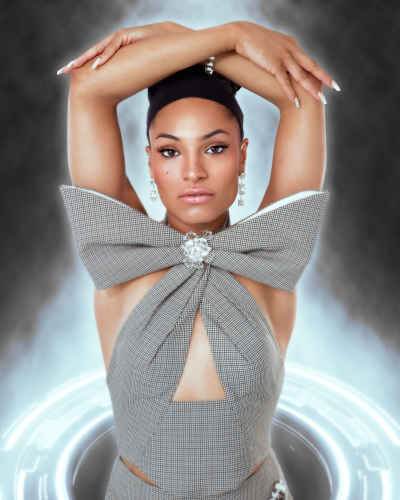
Syana wears AREA top, Magda Butrym earrings and Jil Sander bracelet.
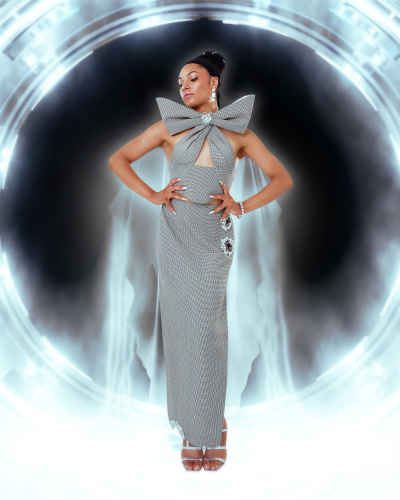
Syana wears AREA top, AREA skirt, Les Petits Joueurs sandals, Magda Butrym earrings and Jil Sander bracelet.
As Beyoncé makes her final costume change, her dancers—who have been impeccably dressed in coordination with Beyoncé’s every look—stage a mini vogue ball. For the first time, they don’t all match. Several wear costumes from the number prior. Another comes out in dazzling “pussy pink.” There is a black velvet leotard with fringe across the breast. There is a fuschia crop top and black skirt. Another dancer wears what appears to be painted patent leather pants and an open jacket. It signals the show is ending, but like the vogue ball itself, it is a call for individuality.
The last performance of the night is “SUMMER RENAISSANCE,” a track so clearly created to close a show even the studio version asks for “a round of applause.” It samples a work that catapulted dance music into the future: 1977’s “I Feel Love.” From her own prechorus, Beyoncé holds a note reborn as the prechorus of “I Feel Love”: “Ooh, I feel good.” It is too smooth and separate to be an example of piggybacking. In Rogers Centre, Beyoncé sings it on horseback, her album cover’s iconic disco-horse now soaring out and over the audience. The references are quotations in her thesis.
RENAISSANCE.
The show ends with Beyoncé flying horseless. There is no gravity in outer space. Confetti drops and for a brief moment she disappears. When she is lowered back to earth, hugging dancers with passion, she does so as a cultural lightning rod. Her massive, Coperni-made metallic cape is silver, the most reflective metal on Earth.
- Text: Michael the III
- Photography: Michael the III
- Styling: Michael the III
- Editing: Michael the III
- Models: Miss Chris Marlot, Kuntiana, Syana Barbara
- Casting: Araya Guanipa, Michael the III
- Production Assistant: Araya Guanipa
- Date: August 7, 2023
.
.
Originally posted from “SSENSE” by Michael the III


No Comments